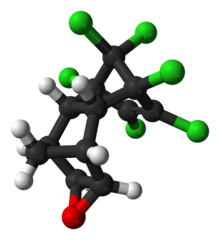
| |

| |
| Names | |
|---|---|
| Preferred IUPAC name
(1aR,2R,2aR,3R,6S,6aS,7S,7aS)-3,4,5,6,9,9-Hexachloro-1a,2,2a,3,6,6a,7,7a-octahydro-2,7:3,6-dimethanonaphtho[2,3-b]oxirene | |
| Other names
Mendrin, Compound 269, 1,2,3,4,10,10-Hexachloro-6,7-epoxy-1,4,4a,5,6,7,8,8a-octahydro-1,4-endo,endo-5,8-dimethanonaphthalene
| |
| Identifiers | |
3D model (JSmol)
|
|
| ChEBI | |
| ChEMBL | |
| ChemSpider | |
| ECHA InfoCard | 100.000.705 |
| EC Number |
|
| KEGG | |
PubChem CID
|
|
| RTECS number |
|
| UNII | |
| UN number | 2761 |
CompTox Dashboard (EPA)
|
|
| |
| |
| Properties | |
| C12H8Cl6O | |
| Molar mass | 380.907 g/mol |
| Appearance | Colorless to tan crystalline solid |
| Density | 1.77 g/cm3 [1] |
| Melting point | 200 °C (392 °F; 473 K) (decomposes) |
| 0.23 mg/L[2] | |
| Vapor pressure | 2.6 x 10-5 Pa[1] |
| Hazards | |
| Occupational safety and health (OHS/OSH): | |
Main hazards
|
Toxic with delayed onset of toxicity |
| GHS labelling: | |
  
| |
| Danger | |
| H301, H310, H351, H372, H410 | |
| P201, P202, P260, P262, P264, P270, P273, P280, P281, P301+P310, P302+P350, P308+P313, P310, P314, P321, P322, P330, P361, P363, P391, P405, P501 | |
| NFPA 704 (fire diamond) | |
| Flash point | noncombustible[3] |
| Lethal dose or concentration (LD, LC): | |
LD50 (median dose)
|
3 mg/kg (oral, monkey) 16 mg/kg (oral, guinea pig) 10 mg/kg (oral, hamster) 3 mg/kg (oral, rat) 7 mg/kg (oral, rabbit) 1.4 mg/kg (oral, mouse)[4] |
LDLo (lowest published)
|
5 mg/kg (cat, oral)[4] |
| NIOSH (US health exposure limits): | |
PEL (Permissible)
|
TWA 0.1 mg/m3 [skin][3] |
REL (Recommended)
|
TWA 0.1 mg/m3 [skin][3] |
IDLH (Immediate danger)
|
2 mg/m3[3] |
Except where otherwise noted, data are given for materials in their standard state (at 25 °C [77 °F], 100 kPa).
| |
Endrin is an organochlorine compound with the chemical formula C12H8Cl6O that was first produced in 1950 by Shell and Velsicol Chemical Corporation. It was primarily used as an insecticide, as well as a rodenticide and piscicide. It is a colourless, odorless solid, although commercial samples are often off-white. Endrin was manufactured as an emulsifiable solution known commercially as Endrex.[5] The compound became infamous as a persistent organic pollutant and for this reason it is banned in many countries.[6]
In the environment endrin exists as either endrin aldehyde or endrin ketone and can be found mainly in bottom sediments of bodies of water.[7][8] Exposure to endrin can occur by inhalation, ingestion of substances containing the compound, or skin contact.[7] Upon entering the body, it can be stored in body fats and can act as a neurotoxin on the central nervous system, which can cause convulsions, seizures, or even death.[9]
Although endrin is not currently classified as a mutagen,[5] nor as a human carcinogen, it is still a toxic chemical in other ways with detrimental effects.[10] Due to these toxic effects, the manufacturers cancelled all use of endrin in the United States by 1991. Food import concerns have been raised because some countries may have still been using endrin as a pesticide.[7]
- ^ a b "Endrin". Deutsche Gesellschaft für Technische Zusammenarbeit. Retrieved 13 March 2015.
- ^ "Endrin (PDS)". IPCS. Archived from the original on 2 July 2014. Retrieved 13 March 2015.
- ^ a b c d NIOSH Pocket Guide to Chemical Hazards. "#0252". National Institute for Occupational Safety and Health (NIOSH).
- ^ a b "Endrin". Immediately Dangerous to Life or Health Concentrations (IDLH). National Institute for Occupational Safety and Health (NIOSH). 4 December 2014. Retrieved 19 March 2015.
- ^ a b Cite error: The named reference
:1was invoked but never defined (see the help page). - ^ "Stockholm Convention on Persistent Organic Pollutants (POPs)". Commonwealth of Australia: Department of the Environment. 2013. Retrieved 30 March 2015.
- ^ a b c "Toxicological Profile for Endrin" (PDF). Agency for Toxic Substances and Disease Registry. United States Department of Health and Human Services. August 1996. Retrieved 30 March 2015.
- ^ Berry, Walter (August 2003). "Procedures for the Derivation of Equilibrium Partitioning Sediment Benchmarks (ESBs) for the Protection of Benthic Organisms: Endrin" (PDF). EPA: Office of Research and Development.
- ^ "Some Acute and Chronic Effects of Endrin on the Brain" (PDF). Federal Aviation Administration: Office of Aviation Medicine. July 1970. Retrieved 14 March 2015.
- ^ "Endrin (CASRN 72-20-8)". Integrated Risk Information System. United States Environmental Protection Agency. September 1988. Retrieved 30 March 2015.
